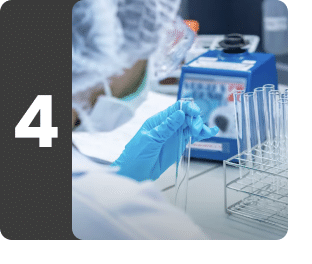Vitamin D (25-Hydroxy)
Understanding Vitamin D (25-Hydroxy)
What is Vitamin D (25-Hydroxy)?
The Vitamin D (25-Hydroxy) test measures the level of 25-OH vitamin D in the body. Vitamin D helps absorb calcium and phosphorus, keeps bones and teeth strong, and supports the immune system. Measures your vitamin D levels to assess bone health, immunity, and overall wellness.
Vitamin D is a fat-soluble essential nutrient. It exists in two primary forms:
- Vitamin D3 (Cholecalciferol): derived from animal sources
- Vitamin D2 (Ergocalciferol): derived from plant sources; both perform similar functions.
The main sources of vitamin D3 are certain foods, dietary supplements, and exposure to ultraviolet B (UVB) radiation from sunlight. On the other hand, vitamin D2 is derived from products or supplements of plant origin, mushrooms, etc. Both forms are converted into 25-hydroxy D2 or D3 respectively in the liver. The Vitamin D (25-OH) test measures only the Total 25-OH D vitamin (i.e. D2+D3) and does not differentiate between the two forms.
As per an NCBI (National Center for Biotechnology Information) study, vitamin D deficiency is highly prevalent across all age groups in India. Insufficient vitamin D levels can increase susceptibility to the following conditions:
- Fractures
- Weakened muscles
- Fatigue
- Compromised immune function
- Higher likelihood of chronic illnesses like diabetes
The Vitamin D (25-Hydroxy) test helps check if you have too little or too much vitamin D, which can happen due to deficiency or taking too many supplements. If such circumstances arise, it may be necessary to discontinue vitamin D supplements and seek medical advice.
Usually, no special preparation is required for this test. A regular diet before taking the test can be consumed. However, it is generally recommended to stop taking vitamin D supplements before the Vitamin D (25-Hydroxy) test, as these supplements may affect the accuracy of the test results.
Test result ranges are approximate and may differ slightly between labs depending on the methodology and laboratory guidelines. Talk to the doctor about specific test results. The test results will help them determine the medical condition, make recommendations for lifestyle modifications such as diet and exercise, prescribe medication if required to manage the condition, and formulate an overall treatment plan.
Lifestyle Tips to Support Healthy Vitamin D Levels:
☀️ Heliotherapy (Sunlight Exposure) or Healthy Sun Exposure: Spend some time outdoors under the sun (preferably in the morning). This helps your body naturally produce vitamin D.
🥙 Eat (Diet): Include vitamin D-rich foods such as eggs, mushrooms, salmon, fortified milk, and orange juice.
🏃 Activity (Exercise): Regular physical activity, especially outdoors, can support better vitamin D synthesis and bone health.
😓 Lifestyle (Stress): Manage stress through yoga or relaxation techniques, as stress can indirectly impact bone health.
👨⚕️ Talk to Your Doctor (Consult): Do not self-medicate and avoid taking high doses of vitamin D supplements.
🚬 Habits (Alcohol & Smoking): Limit alcohol and quit smoking, as these can affect vitamin D metabolism and bone strength.
What is Vitamin D (25-Hydroxy) used for?
The Vitamin D (25-Hydroxy) test can be done:
A. In Symptomatic Individuals
- Bone or joint pain
- Chronic fatigue
- Muscle weakness or cramps
- Susceptibility to frequent infections
B. In High-Risk Groups
- Osteoporosis or other bone disorders
- Inflammatory bowel disease
- Malabsorption syndromes (e.g., celiac disease, Crohn’s)
- Chronic kidney or liver diseases
C. In Special Population
- Pregnant and lactating women
- Elderly individuals
- Infants receiving exclusive breastfeeding
D. In Individuals With Lifestyle-Related Risks
- Limited sun exposure
- Strict vegan diet
- Obesity
What does Vitamin D (25-Hydroxy) measure?
The Vitamin D (25-Hydroxy) test measures the levels of vitamin D in the body. It is an essential nutrient that can be synthesized in the body upon healthy exposure to sunlight or absorbed from dietary sources. It majorly exists in two forms: vitamin D2 (ergocalciferol) and vitamin D3 (cholecalciferol). Vitamin D2 is present in plants, such as yeast or mushrooms, and is available as a supplement in fortified foods, and vitamin D3 is found in foods like cheese, green vegetables, mushrooms, egg yolks, and fatty fish.
Both forms of vitamin D (D2 and D3) need to undergo some chemical changes before being available for use in the body. These chemical changes take place in the liver or kidneys. The levels of 25-hydroxy vitamin D in blood are considered the best parameter to assess the vitamin D status of the body. This test measures the level of Total 25-OH vitamin D (D2+D3), but it does not differentiate between the two forms, as it is the major form of vitamin D that circulates in the blood.
Interpreting Vitamin D (25-Hydroxy) results
Interpretations
A lower vitamin D level than the normal reference range indicates vitamin D deficiency, which can be because of less sun exposure, dietary lack, or decreased absorption from the intestine.
A higher vitamin D level than the normal reference range indicates vitamin D intoxication, usually due to excess vitamin supplementation.
Range:
The vitamin D range is measured as nanograms per milliliter (ng/mL) or nmol/L and can vary from lab to lab.
|
Level |
Reference range (ng/mL) |
|
Deficiency |
<20 |
|
Insufficiency |
20-29 |
|
Sufficiency |
30-100 |
|
Toxicity |
>100 |
Note:
- This test does not include a separate vitamin D2 and D3 level analysis.
- There can be seasonal variation in 25 (OH) vitamin D levels, with values being 40-50% lower in winter than in summer. It is also influenced by sunlight, latitude, skin pigmentation, sunscreen use, and hepatic function.
- 25 (OH) vitamin D levels can vary with age.
- 25 (OH) vitamin D level is increased during pregnancy.
Answers to Patient Concerns & Frequently Asked Questions (FAQs) about Vitamin D (25-Hydroxy)
Frequently Asked Questions about Vitamin D (25-Hydroxy)
Q. What is the vitamin D test used for?
Q. What are the signs and symptoms of low vitamin D levels?
Q. How much vitamin D is needed daily?
Q. What are the causes of vitamin D deficiency?
Q. What is the right time to get the Vitamin D (25-Hydroxy) test done?
Q. Are there any risks associated with the Vitamin D (25-Hydroxy) test?
Q. Who should be tested for vitamin D?
Q. What are some of the common vitamin D benefits for the body?
Q. What are some of the easily available vitamin D food sources for vegetarians?
Q. What are the additional lab tests needed to be performed in case of abnormal vitamin D test results?
Q. What are some of the common side effects of vitamin D overdose?
Q. What is osteomalacia?
Q. What is osteoporosis?
Q. Is there any correlation between the nutrients vitamin D and calcium?
Book a Vitamin D (25-Hydroxy) test at home near me





Other tests









